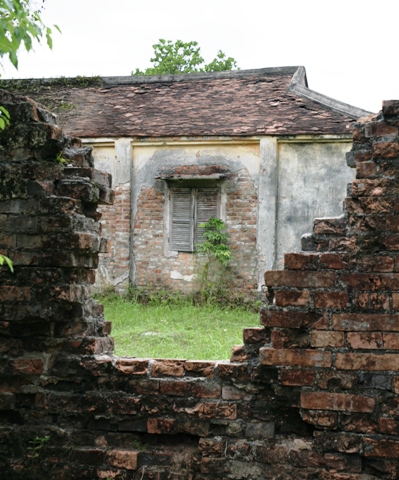| Ken and Bill's Excellent Adventure |
| XIV. Towers, Tombs and Tunnels This time, we were able to reach the Citadel without a shot being fired. |
| The Imperial City of the Nguyen Dynasty, the last emperors of Vietnam, it shows both the ravages of the savage fighting and the deterioration from decades of neglect. Designated a World Heritage Site, only slowly is it being rebuilt by the Vietnamese with help from UNESCO, but the portions that have been restored suggest a magnificent opulence to rival anything Europe’s crowned heads could boast of. |
 |
 above: A small portion of the Citadel that has been restored to its original grandeur. (AGE) Above left: One of the many portions of the Citadel that have yet to be restored. (SA) Bottom left: The massive entrance to the Imperial City of the Citadel, looking from the interior out. The Vietnamese flag is actually on another building beyond the building that is visible. (SA) |
 |
| We also visited the tombs of Tu Duc, 4th Nguyen emperor (1848-1883), and Khai Dinh, 12th Nguyen emperor (1916-1925). Tu Duc, known as the “poet-emperor,” placed his tomb on the grounds of the summer palace he built for himself, his wife, and his concubines. The history of his reign, which he wrote himself, is carved into a marble tablet weighing 20,000 kilograms, and is unique in that Tu Duc was the first Vietnamese emperor to criticize himself in his own history. The tomb of Khai Dinh is by far the most expensive of the twelve Nguyen tombs, and was built entirely of materials imported from Europe. By the time of his reign, Vietnam was firmly in France’s colonial grip, and Khai Dinh was little more than a figurehead doing the bidding of the French. The pomposity of his tomb reflects the emptiness of his reign. Only one more Nguyen emperor would follow him, the laughably pathetic Bao Dai, who took the throne as a child in 1925, spent most of his reign womanizing on the French Riviera, abdicated in favor of Ho Chi Minh in 1945, rescinded his abdication and returned to the French fold in 1948, got voted out in favor of Ngo Dinh Diem in a 1955 election rigged by Diem with the support of the Americans, and died in 1997 in France, where he is buried. One morning we took a boat ride up the River of Perfumes to visit the Holy Lady Pagoda and Monastery, built in 1603, where young boys of six and seven still begin training to be monks, choosing after high school whether to remain or go out into the world. On display is the Austin automobile that carried Thich Quang Duc to Saigon in 1963, where he burned himself to death in protest of Diem’s persecution of Buddhists. The car is here because Thich Quang Duc was the monastery’s head monk. |
 At the summer palace and tomb of Emperor Tu Duc. The large tablet in the center of the arch is the history of Tu Duc’s reign. (SA) |
 The seven-tiered Holy Lady Pagoda (SA) |
 Photographer Sachiko Akama at Holy Lady Pagoda & Monastery. The bell is the largest of its kind in all of Vietnam. (AGE) |
 A tiny portion of the lavishly decorated interior of Khai Dinh's tomb. (AGE) |
| On another day, we drove from Hue to the old Demilitarized Zone marked by the Song Ben Hai. We walked—stoop-shouldered most of the way—through the tunnels of Vinh Moc just north of the DMZ, where an entire village of 70 families lived underground for six years to escape U.S. bombardment. We walked across the river, from north to south, on the Hien Luong Bridge, destroyed by U.S. bombing in 1967, but rebuilt post-war for pedestrian traffic. Several miles to the west of the bridge is Con Thien (“the place of angels” in Vietnamese), where Ken and I had spent a month living in a mud-infested, barbed wire-encircled collection of sandbagged bunkers, besieged by North Vietnamese artillery from the north side of the DMZ, but we could not go there because the area, still sewn with American mines, is too dangerous. |
 The Austin in which Thich Quang Duc rode to Saigon to immolate himself in protest of Diem’s repression of Buddhists in 1963. Holy Lady Monastery, Hue. Malcolm Browne’s famous photograph is visible on the wall behind the car. (SA) |
 A cubicle housing one of the 70 families who lived in the Vinh Moc tunnels during the American War. The figures make it clear how cramped the quarters were. (AGE) |
 Ken and Bill straddling the 17th parallel at the old DMZ. (SA) |
| (Background photo by SA) | Continue to next section |
Copyright © 2011 - W. D. Ehrhart - homepage